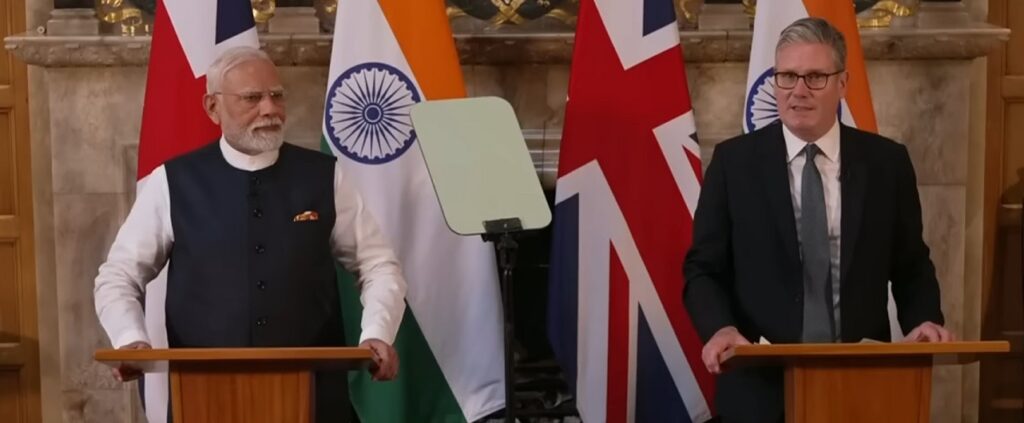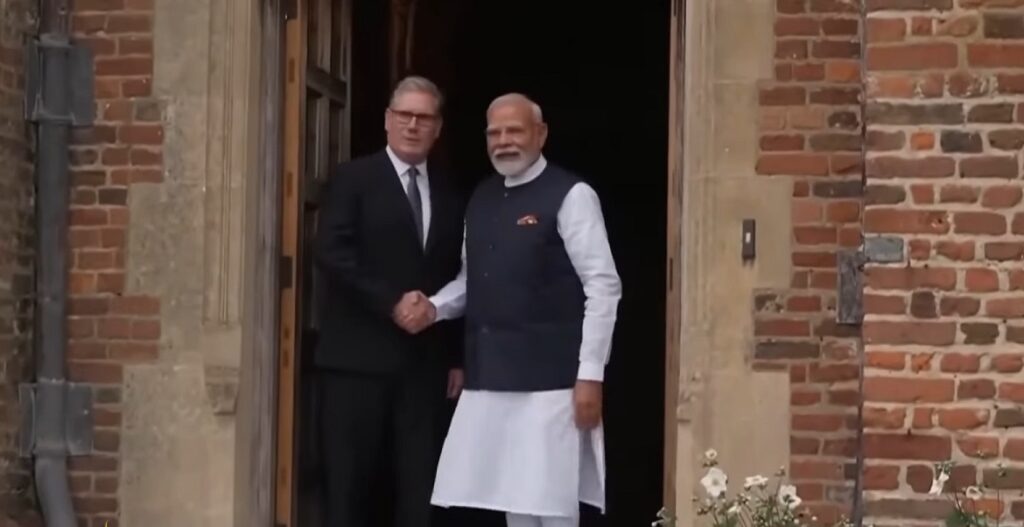
In a groundbreaking development poised to reshape global trade dynamics, India and the United Kingdom have signed a landmark Free Trade Agreement (FTA), marking a new era of economic cooperation and strategic alignment between the two major economies. The Comprehensive Economic and Trade Agreement (CETA), finalized after nearly three years of intense negotiations, is projected to boost bilateral trade by more than $34 billion annually and double total trade to over $112 billion by 2030.
Signed in the presence of Indian Prime Minister Narendra Modi and his UK counterpart Keir Starmer, the deal slashes tariffs, opens new sectors, and sets the stage for long-term economic collaboration.
🔍 Key Highlights of the India-UK Trade Deal
- 99% of Indian exports to the UK will now enter duty-free.
- UK exports to India will see average tariff reduction from 15% to 3%.
- Tariffs on Scotch whisky halved immediately, with further cuts to 40% over 10 years.
- Electric vehicle duties cut from 110% to 10% under a quota system.
- Indian professionals can now work in 35 UK sectors for up to 2 years without local offices.
- UK businesses gain expanded access to India’s 1.4 billion-strong market.
A Strategic Win for Both Economies
Described by economists as a “strategic win” for New Delhi’s trade diplomacy, this FTA is one of the first India has signed with an advanced economy. It delivers a major push for labour-intensive sectors such as textiles, gems and jewellery, and agriculture. Indian Commerce Minister Piyush Goyal called it a gateway to “$23 billion in new export opportunities”, promoting inclusive and gender-equitable growth.
From the UK’s side, this agreement helps offset post-Brexit economic disruptions, giving British exporters access to one of the world’s fastest-growing economies. Prime Minister Keir Starmer described it as a deal that will “boost wages, improve living standards, and lower prices for consumers”.

What Gets Cheaper for Consumers
With tariff reductions across sectors, consumers in both countries will benefit:
- In India:
- Cheaper UK-made medical devices, cars, chocolates, cosmetics, and soft drinks.
- Scotch, gin, brandy, and rum to become significantly more affordable.
- Tariffs on aerospace parts and salmon also slashed.
- In the UK:
- Duty-free access for Indian textiles, engineering goods, jewellery, leather products, and agricultural produce.
- Better pricing and availability of Indian processed foods and spices.
Boost for Employment and Industry in India
The tariff exemptions are expected to supercharge Indian manufacturing and job creation. By improving access to the British market, the deal supports the ‘Make in India’ initiative, helping Indian products integrate into global value chains.
Economist Samiran Chakraborty of Citi Bank noted that India’s average tariffs on UK goods were 14.6% prior to the deal, while the UK applied only 4.2% on Indian goods — a disparity now significantly reduced.
This FTA also exempts Indian temporary workers from UK social security contributions for three years, further reducing the cost of overseas employment and promoting mobility of skilled professionals.
A Template for Future Trade Partnerships
Analysts believe this agreement sets a global benchmark for ethical and sustainable trade. It includes progressive clauses on:
- Labour rights
- Gender equality
- Anti-corruption measures
It also introduces a ‘Vision 2035’ roadmap, which emphasizes cooperation in defence, technology, green energy, education, and climate action — expanding the agreement’s impact beyond traditional trade.
“This is more than just a trade pact. It is a signal to the world that India and the UK are serious about shaping a shared, sustainable future,” said Sameep Shastri, Vice President of the BRICS Chamber of Commerce and Industry.
Strengthening Global Leverage
The timing of the deal also adds geopolitical weight. Coming ahead of India’s talks with the U.S. to avoid impending 26% tariffs, and amid the UK’s ongoing post-Brexit efforts to strike new trade partnerships, the CETA gives both nations greater leverage in global trade negotiations.
Alicia Garcia Herrero, Chief Economist at Natixis Bank, said the deal gives both countries “leverage versus the U.S.” and strengthens their positions in future multilateral agreements.
A Generational Inheritance
Prime Minister Modi has hailed the trade deal as “a blueprint for shared prosperity,” emphasizing its value for future generations. By enabling better market access, job creation, educational exchange, and collaborative innovation, the agreement provides a legacy of opportunity for young Indians and Britons alike.
The CETA also ensures mutual recognition of qualifications, supporting cross-border careers and knowledge exchange — a critical factor for growth in a digitized, interconnected global economy.
Final Hurdle: Parliamentary Ratification
Though the agreement has been signed, it still awaits ratification by both India’s and the UK’s parliaments, a process expected to take several months. Once approved, the deal will come into full force and unlock the projected trade and economic benefits.